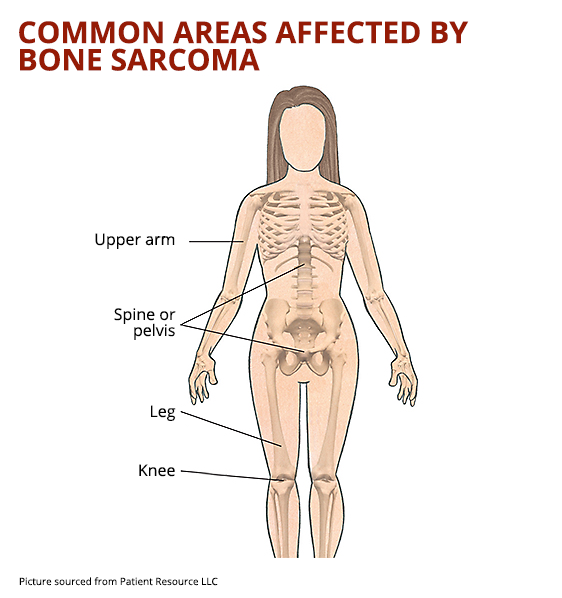Bone Sarcoma

Bone sarcoma is a rare type of cancer that arises from bone and cartilage, commonly presenting with a painful lump (tumour) in limbs. The most common places where bone sarcoma develops are around the knee, wrist, shoulder and pelvis.
About 200 Australians are diagnosed with bone sarcoma each year; and is more common among children, youth and young adults.
Bone sarcoma is different from secondary bone cancer, which is cancer that spreads to the bones after developing in another part of the body.
Subtypes of Bone Sarcoma
Three most common types include:
- Osteosarcoma (accounts for about 35% of bone sarcoma)
- Starts in cells that grow bone.
- Often affects the arms, legs and pelvis, but may occur in any bone.
- More commonly affects children, adolescents and young adults within growing bones; and older people in their 70s and 80s.
- Osteosarcoma as high-grade tumours.
- Chondrosarcoma (accounts for about 30% of bone sarcoma)
- Starts in cells that grow cartilage.
- Often affects the bones in the upper arm and legs, pelvis, ribs and shoulder blade.
- More commonly affects people aged over 40.
- Chondrosarcoma as low-grade tumours – a slow-growing form of cancer that rarely spreads to other parts of the body.
- Ewing sarcoma (accounts for about 15% of bone sarcoma)
- Affects cells in the bone or soft tissue that rapidly and often have a large lump associated with it.
- Often affects the pelvis, legs, ribs, spine and upper arms.
- It is more common among children, youth and young adults, but it can occur at any age.
- Ewing sarcoma as high-grade tumours.
Causes
While the causes of most bone sarcomas are unknown, there are several risk factors.
Risk Factors
Factors that may increase a person’s risk of bone sarcoma include:
- Previous radiotherapy, particularly for people who received high doses at a young age.
- Other bone conditions such as Paget's disease of the bone, fibrous dysplasia or multiple enchondromas.
- Genetic factors such as inherited conditions like Li-Fraumeni syndrome, and a strong family history of certain cancers.
Symptoms
The most common symptom of bone sarcoma is a pain in the bones and joints. The pain gradually becomes constant and does not improve with mild pain-relieving medicines. It may be worse at night or during activity.
Other symptoms can include:
- Swelling over the affected part of the bone
- Stiffness or tenderness in the bone
- Problems with movement, such as an unexplained limp
- Loss of feeling in the affected limb
- A fractured bone
- Unexplained weight loss
- Fatigue
Most people who have these symptoms do not have bone sarcoma. However, if you have symptoms for more than two weeks, you should see your GP.
Diagnosis
If your GP feels there's a possibility you have cancer, they'll refer you for a number of hospital tests.
Diagnosis for bone sarcoma will usually be made by a health specialist and will be based on your symptoms, a physical examination and the results of:
- Scans – X-rays, magnetic resonance imaging (MRI), positron emission tomography (PET) or computed tomography (CT) scans are usually the first of diagnosis.
- Bone biopsy – a sample of suspected cancerous tissue is removed, using a needle or during an operation it can be tested and analysed in a laboratory.
If a diagnosis of a bone sarcoma is confirmed, a pathologist will further examine how likely the cancer is to spread (known as grade), and whether or how far the cancer has spread (known as stage).
Treatment
Osteosarcoma and Ewing sarcoma are treated with multimodality (combination) approach including chemotherapy, surgery and/or radiotherapy. Chondrosarcoma is generally managed with surgery alone.
- Surgery
- Limb-sparing surgery – taking out and a margin of healthy tissue while still keeping your limb.
- Amputation – sometimes it is not possible to remove all without affecting the arm or leg. In these cases, the health specialist may advise that the only effective treatment will be to remove the limb. However, this is becoming less common with the improvement limb-sparing surgery.
- Radiotherapy – uses high-energy radiation to kill cancer cells.
- Chemotherapy – the use of anti-cancer drugs to kill cancer cells.
Information sourced from:
- Cancer Council Victoria - https://www.cancervic.org.au/cancer-information/types-of-cancer/bone_cancer/primary-bone-cancer-overview.html
- Kick Sarcoma - https://kicksarcoma.org.sg/what-are-sarcomas/types-of-sarcomas/
- NHS - https://www.nhs.uk/conditions/bone-cancer/
- Mayo Clinic - https://www.mayoclinic.org/diseases-conditions/bone-cancer/symptoms-causes/syc-20350217
- The Liddy Shriver Sarcoma Initiative - http://sarcomahelp.org/sarcoma-treatment.html#tpm1_3

